Inside: A collection of identity artworks to help students explore and understand their own identity and relate to others around them.

Have you ever wondered, ‘Who am I?”
Have you ever thought about how who you’re around and where you are affects the person who become? Consider how you’ve changed over time and what sparked those shifts in your identity. The answers are not always as straightforward as we might imagine.
Artists have long explored themselves and others through identity artworks. Portraiture and personal expression have been an integral part of art since the first handprints were left on cave walls.
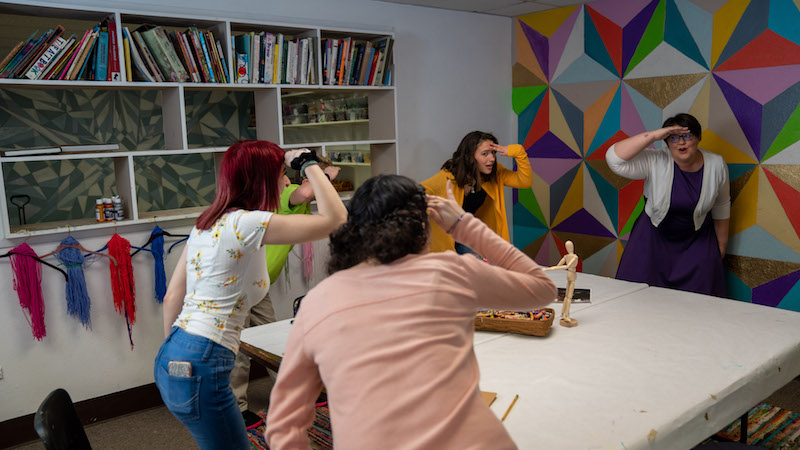
Art class is the perfect place for students to explore their own identity and connect with others who may or may not share their traits.
You can find lessons for all 15 of these artworks included in this post in the Curated Connections Library, complete with presentations, discussion questions, worksheets, and more.
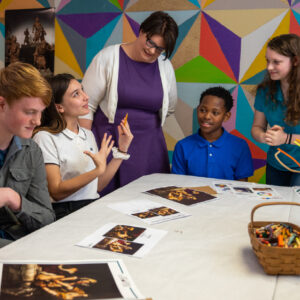
Get the Full Lesson!
This Lesson is in The Curated Connections Library!
Find the full lesson from this post along with hundreds of other art teaching resources and trainings in the Curated Connections Library. Click here for more information about how to join or enter your email below for a free SPARKworks lesson from the membership!
Identity Artworks

Rosa Rolanda, Autorretrato (Self-Portrait)
Rolanda worked frequently with Frida Kahlo and Diego Rivera while living in Mexico. Early in her career, she experimented with photography and it is thought she may have been influenced by Man Ray. Many of her paintings consist of brightly colored folklore scenes featuring festivals, children, and portraits of her friends.
Lesson: Rosa Rolanda Jigsaw Art Learning Activity: Each Piece Tells a Story
With her marriage crumbling, Rolanda painted this self portrait of her in turmoil. Her hands clasped her ears as if refusing to hear reality. The clock in the lower right symbolizes the passing of her youth. The tossing figures represent Mexico City dance company where Covarrubias was the director, and where he met a dancer 30 years his junior — the affair tore their marriage apart.
-Soodie Beasley
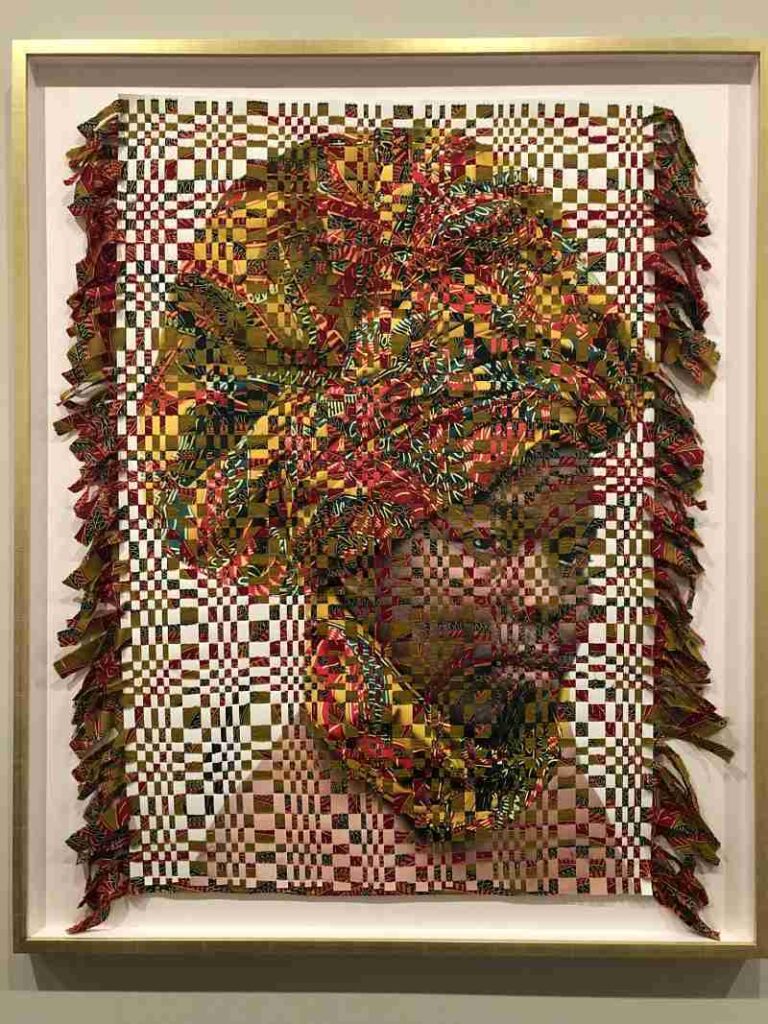
Kyle Meyer, Unidentified 48 from the series Interwoven
Meyer uses his photography background to address the question: “How can a digital image serve any human connection when it is entirely produced – and ubiquitously reproduced – by mechanical means (camera, computer, printer)?”
He also seeks to explore his own identity as a gay man within the LGBTQ communities. He draws upon his experiences growing up in conservative rural Ohio and living in Swaziland where homosexuality is illegal.
For my series Interwoven, I explore the challenges of homosexuality in a hyper-masculine culture within Swaziland. Given that homosexuality is illegal in this small African country, gay men constantly have to hide their sexuality and suppress their true identity. After befriending several gay men in Swaziland, who confided in me their personal stories of struggle, I asked them to choose a piece of fabric typically worn by women with which I made unique wraps on each of their heads. It would be taboo for men to wear these head-wraps in public, as that would indicate homosexual tendencies. This was one simple way for them to express their individuality that they regularly have to hide.
-Kyle Meyer

Angelica Kauffmann, Self Portrait of the Artist Hesitating between the Arts of Music and Painting
Kauffmann was a child prodigy, skilled at both painting and music. She struggled to choose which art to pursue, as shown in this self portrait.
It presents the artist as a kind of female Hercules, choosing not between Virtue and Vice, but between her profession as a painter, which was traditionally a male dominated field (the figure of Painting points to a far away temple, symbolizing the difficulty of her journey), and a career devoted to the easier, more traditionally feminine, Art of Music. In recent years, this self portrait has become an icon of the feminist interpretation of art history.
-Arthur, Digital Museum
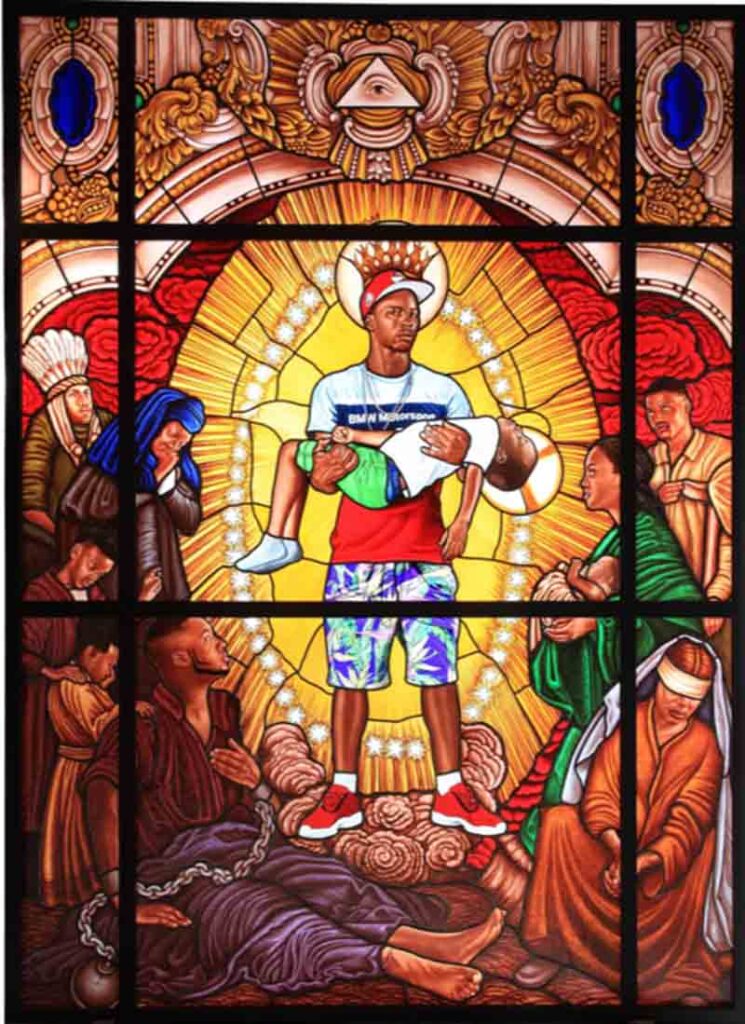
Kehinde Wiley, Mary, Comforter of the Afflicted I
Wiley is known for his portraits of black people in grand poses with bold, patterned backgrounds—including the official portrait of President Barak Obama. He references art history in many of his paintings, substituting contemporary black figures in place of the people in the original work. This piece was inspired by an artwork featuring the Biblical figure Mary.
Lesson: Portraits for a New Century: Kehinde Wiley Art Lesson
My work is not about paint. It’s about paint at the service of something else. It is not about gooey, chest-beating, macho ’50s abstraction that allows paint to sit up on the surface as subject matter about paint.
-Kehinde Wiley

Sadie Red Wing, Lakȟóta + Dakȟóta Visual Essay
Visual Essay was created because the artists wants to preserve and communicate the Lakȟóta visual language and share her cultural perspective. Each element represents a different aspect of the
artist’s life, journey, and cultural heritage by using Lakȟóta symbols.
If you cannot be comfortable in your own skin, it reflects in your work, studies, and communication.
-Sadie Red Wing
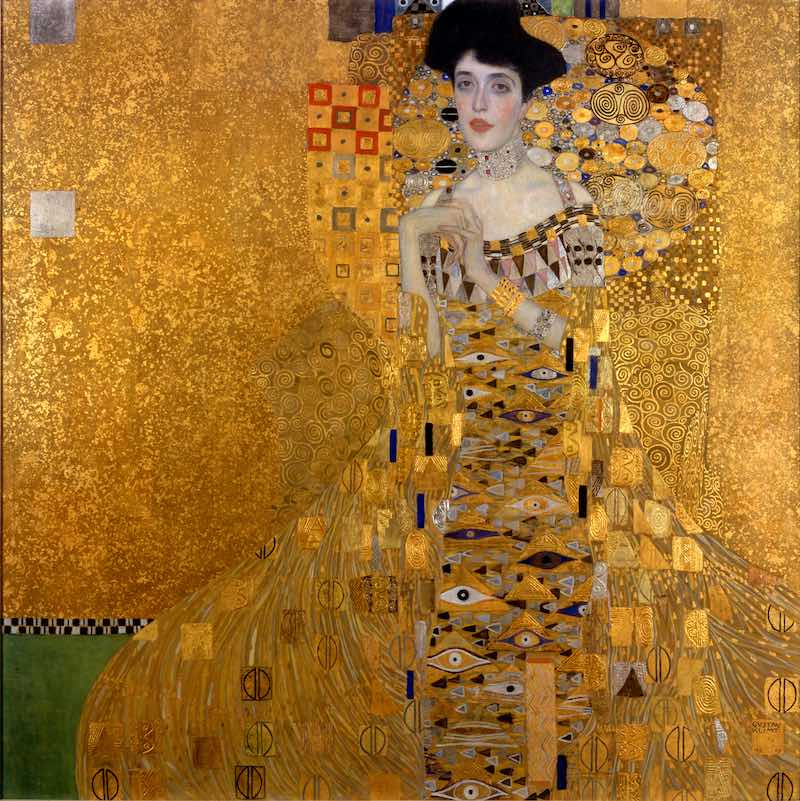
Gustav Klimt, Adele Bloch-Bauer I
One of Klimt’s most famous paintings, this work is often called Woman in Gold. Her true identity was obscured because she came from a prominent Jewish family during the rise of Nazism and World War II. This artwork is a great way to talk about identity with your students by exploring the difference between how we see ourselves versus how others see us.
Ignore the gold. That’s Klimt. Look at my face. Does it resemble me?
-Antje Traue as Adele Bloch-Bauer in the 2015 film Woman in Gold
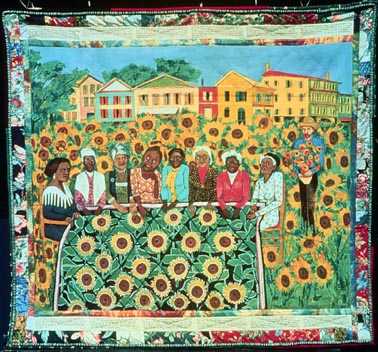
Faith Ringgold, The Sunflower Quilting Bee at Arles
These women included in this artwork are influential leaders and important figures in American history including (from upper left) Madam Walker, Sojourner Truth, Ida Wells, Fannie Lou Hammer, Harriet Tubman, Rosa Parks, Mary McLeod Bethune, and Ella Baker. The ninth woman is a fictional character invented by Ringgold named Willa Marie Simone. Vincent van Gogh stands behind them.
Lesson: Faith Ringgold’s Celebration of African American Women
I had something I was trying to say and sometimes the message is an easy transmission and sometimes it’s a difficult one, but I love the power of saying it so I’m gonna do it whether it’s hard or easy.
-Faith Ringgold
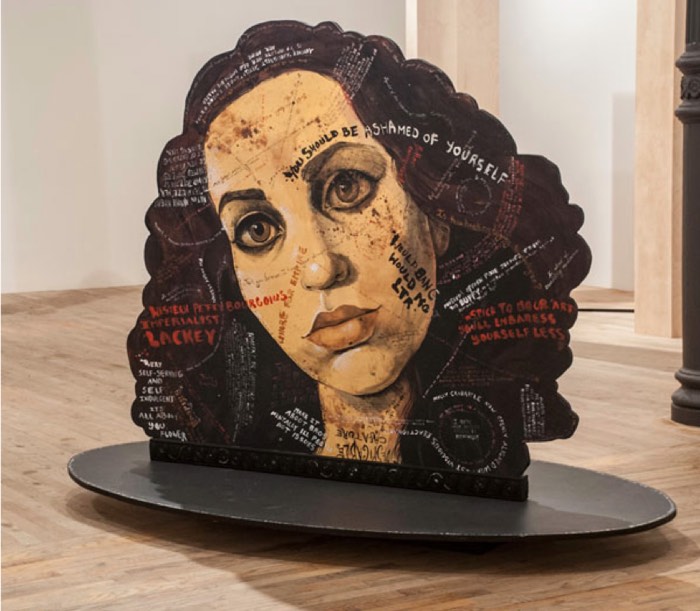
Molly Crabapple, Portraits of myself and Lola Montes with things said about us by our contemporaries
This artwork is a powerful, transfixing two-sided sculpture that confronts the dark side of social media—focusing on the pervasive culture of bullying and how hurtful words hurled through a screen can erode confidence and self-esteem.
Lesson: Things Said About Us: Art-Inspired Self Esteem Activity for Kids
If there’s a theme in my work, it’s that I like to focus on smart people who are facing oppression and who are fighting back against it.
-Molly Crabapple

Frida Kahlo, Self-Portrait with Cropped Hair
Frida Kahlo painted this after she divorced Diego Rivera. The lyrics from the Mexican song translate as, “Look, if I loved you it was because of your hair. Now that you are without hair, I don’t love you anymore.” Changing your appearance when you’re going through changes in your life is a typical part of reshaping identity and one students will relate to.
I paint self-portraits because I am so often alone, because I am the person I know best.
-Frida Kahlo

Tracey Moffatt, Useless
Each photograph from Moffatt’s photo series Scarred for Life documents small, but not insignificant, bad things that happen to us in our lives—small digs at our worth in the world that slowly bring us down and subconsciously teach us about society, how it works, and how we fit in (or don’t).
Lesson: Scarred for Life: Using Art to Analyze the Small Moments that Define Us
My work is full of emotion and drama, you can get to that drama by using a narrative, and my narratives are usually very simple, but I twist it. There is a storyline, but there isn’t a traditional beginning, middle, and end.
-Tracey Moffatt

Anila Quayyum Agha, All the Flowers Are for Me
This immersive artwork draw inspiration from the Agha’s home of Pakistan. The geometric patterns
are characteristic of Islamic Art. She was inspired by opposing forces such as light and shadow, life and death, and chose red because brides in Pakistan often wear red. Many of Agha’s artworks are meant to create welcoming places where no one feels like an outsider.
This artwork offers us an opportunity to explore our place in the world—where we feel welcomed and comfortable and where we don’t. It also gives students the chance to consider the spaces that are and are not welcoming to all and how those places and interactions shape our identity.
Artists have the ability to bring historical perspectives to the current time. I’m interested in that thought process of taking responsibility and seeing how we can move to the future and make a better environment for people.
-Anila Quayyum Agha

Cindy Sherman, Untitled Film Still #21
When first looking at this image, you might think it is merely a candid photo of a young woman on a
city street, but that is not the case. Sherman set it up to look as though she, herself, is a female
character from a black and white movie of the 1950s-60s. For this series, the artist played with identity—dressing as different characters by putting on wigs, clothing, and make up, then placing herself in carefully framed scenes meant to evoke film stills.
If I knew what the picture was going to be like, I wouldn’t make it.
-Cindy Sherman
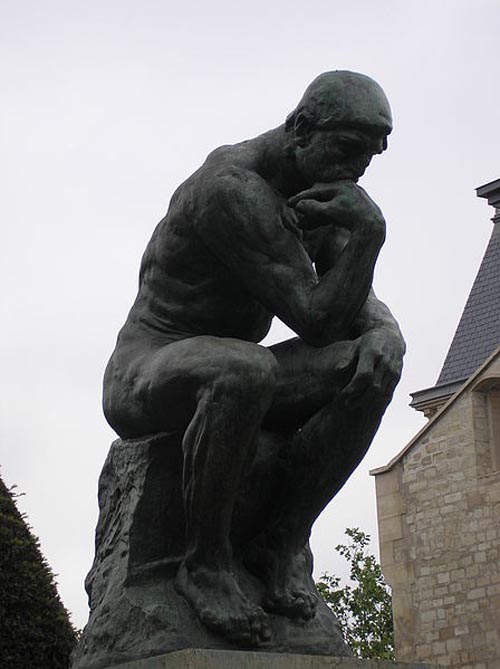
Auguste Rodin, The Thinker
Rodin was a master of manipulating light and shadow. Even though The Thinker is just sitting, he wanted it to seem as though it moved. He manipulated the face with extra clay to make it seem as though the facial expression changes as you move around the sculpture—inviting us to ponder our own lives and identities.
I invent nothing, I rediscover.
-Auguste Rodin

Margaret Macdonald Mackintosh, The Mysterious Garden
Perhaps as a part of a dream, eight heads or masks float above a seemingly sleeping figure. It is thought that this work was inspired by the play The Blue Bird by Maurice Maeterlinck.
Margaret has genius, I have only talent
-Mackintosh’s husband, Charles Rennie Mackintosh

Marcos Raya, The Anguish of Being and the Nothingness of the Universe
This artwork depicts an inside-out view of Raya’s head and explores the social impact of
technology on humanity, as well as his personal battle with alcoholism. Raya painted several versions of this painting, each has different views through the eyes.
Creating is a revolutionary act.
-Marcos Raya





You left out RENEE COX who has been doing self portraits since the 90 s ( YO MAMAS LAST SUPPER 2001)
Thank you for bringing this artwork to our attention.